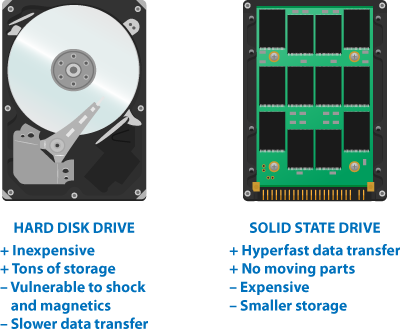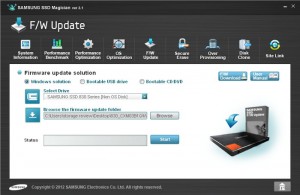| Snažíme se lokalizovat naše webové stránky v co největším počtu jazyků, jak je to možné, ale tato stránka je v současné době stroje přeloženy pomocí Google Translate. | zavřít |
-
-
produkty
-
prostředky
-
podpora
-
společnost
-
Jak nahradit pevný disk s SSD na vašem PCHow to Replace a Hard Drive with SSD on your PC
Podle Steve Horton Květen 11, 2012hard drive, HDD, SDD, solid state driveŽádné komentářeIlustrace: Gordon McAlpin Takže byste chtěli jít na cestu Solid State Drive (SSD). Možná jste slyšeli, že tyto typy jednotek jsou mnohem rychlejší než pevné disky a jsou ideální pro Windows a aplikace, zatímco pevné disky jsou vhodné pro filmy a jiné velké soubory.
Níže uvedená příručka vysvětluje, jak na počítači vyměnit pevný disk s jednotkou SSD:
Krok 1: Zálohujte data
Při přesunu z pevného disku na jednotku SSD pravděpodobně půjdete z velkého disku na menší disk a budete muset zálohovat některé ze svých dat do externího zdroje. Tato příručka nabízí podrobnosti o nejlepších metodách zálohování. Budete muset buď klonovat disk, Windows a všechny, nebo přeinstalovat systém Windows na nové jednotce a přesunout dokumenty selektivně.
- Klon nebo obrázek
- Můžete také klonovat nebo zobrazovat starý disk a obnovit obraz na novou jednotku. (Budete potřebovat jinou jednotku pro dočasné uložení tohoto velkého obrázku.) To má tu výhodu, že zachováte všechna nastavení pro programy s řízením digitálních práv, jako je samotný systém Windows. Nikdo nechce, aby svůj kód znovu vložil. K tomu však musí být použitý prostor na starém disku menší nebo rovný velikosti nové jednotky. Doporučuji přesunout všechny vaše velké mediální soubory, například filmy, na jiné místo, abyste si před klonováním zvedli velikost. Většina řešení založená na jednotkách na výše uvedeném odkazu, včetně vestavěného systému Windows Backup and Restore, podporuje vytváření obrazu staré jednotky.
- Zálohování následované novou instalací systému Windows
Třetí možností je zálohovat konkrétní soubory na nové místo, pak zbrusu novou instalaci systému Windows na jednotku SSD a přesunout soubory ze zálohy. Čisté instalace systému Windows mají méně chyb a zbrusu nová jednotka se jí líbí, když je méně chyb. To má nevýhodu, že požadujete znovu zadat instalační kódy pro mnoho aplikací.Krok 2: Vyjměte pevný disk a nainstalujte jednotku SSD
Obvykle to bude tak jednoduché, jako otevření počítače a výměna jednotek a zachování stejných kabelů. Nejprve odpojte počítač od napájení. Někdy bude váš nový disk mít jiný tvar než starý disk (což znamená, že je příliš malý na místo) a v takovém případě budete potřebovat samostatný rám nebo pouzdro.
Všimněte si, že pokud je na ploše více než jedna otevřená pozice disku, není důvod instalovat jednotku SSD spolu s pevným diskem namísto místo. V tomto případě,
Krok 3: Obnovení ze zálohy
Bez ohledu na způsob zálohování, který jste si vybrali, je po instalaci nové jednotky vhodný čas pro obnovení z této zálohy, a to pouze v případě, že Windows bude mít zpět na jednotku, takže můžete dělat další věci. Bude možná muset naformátovat disk (vymazat její obsah), než je možné obnovit; Systém Windows vás provede automaticky.
Příklad aplikace aktualizace firmwaru pro jednotku SSD. Krok 4: Aktualizujte firmware na jednotce SSD
Firmware je kód na vašem pevném disku, který mu pomáhá správně pracovat s počítačem. Novější firmware udržuje jednotku bez chyb, pomáhá ji pracovat s novějším hardwarem a udržuje rychlost a spolehlivost vyšší.
Uveďte číslo modelu vašeho disku Google specifickými pokyny; to obvykle zahrnuje spuštění nástroje z Windows. Nezapomeňte ponechat počítač v chodu po celou dobu aktualizace firmwaru, aby nedošlo k poškození počítače.
Poznámka: Nezapomeňte, že defragmentujte disky SSD, protože tyto disky se tak dělají automaticky a spuštění defragmentace na nich nebude mít žádnou výhodu.
Další poznámka: Ujistěte se a povolte nástroj TRIM, pokud používáte jednotku SSD se systémem Windows 7. Je to pro pokročilé uživatele, ale pomáhá udržovat a zlepšovat výkon disku. Zde je návod, jak to udělat .
Využijte výhod rychlosti a spolehlivosti vašeho SSD. Jedná se o jeden z nejvyšších poměrů rychlosti a nákladů na jakoukoli inovaci, kterou můžete provést.
Was this post helpful?YesNoVolný, uvolnit Aktualizace ovladačů
Aktualizujte své ovladače za méně než 2 minuty, abyste si mohli užívat lépe výkon PC - Volný, uvolnit.
Volný, uvolnit Aktualizace ovladačů
Aktualizujte své ovladače za méně než 2 minuty, abyste si mohli užívat lépe
výkon PC - Volný, uvolnit.
Nenašli jste odpověď?Zeptejte se na naší komunity odborníků z celého světa a obdržet odpověď v žádném okamžiku vůbec.most relevant poslední články Připněte si to na Pinterest


